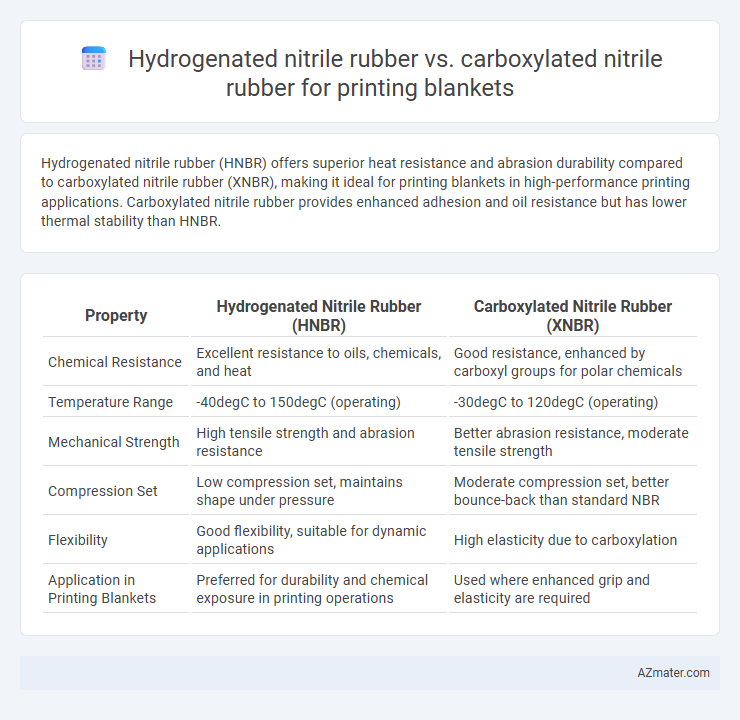Hydrogenated nitrile rubber (HNBR) offers superior heat resistance and abrasion durability compared to carboxylated nitrile rubber (XNBR), making it ideal for printing blankets in high-performance printing applications. Carboxylated nitrile rubber provides enhanced adhesion and oil resistance but has lower thermal stability than HNBR.
Table of Comparison
| Property | Hydrogenated Nitrile Rubber (HNBR) | Carboxylated Nitrile Rubber (XNBR) |
|---|---|---|
| Chemical Resistance | Excellent resistance to oils, chemicals, and heat | Good resistance, enhanced by carboxyl groups for polar chemicals |
| Temperature Range | -40degC to 150degC (operating) | -30degC to 120degC (operating) |
| Mechanical Strength | High tensile strength and abrasion resistance | Better abrasion resistance, moderate tensile strength |
| Compression Set | Low compression set, maintains shape under pressure | Moderate compression set, better bounce-back than standard NBR |
| Flexibility | Good flexibility, suitable for dynamic applications | High elasticity due to carboxylation |
| Application in Printing Blankets | Preferred for durability and chemical exposure in printing operations | Used where enhanced grip and elasticity are required |
Overview of Printing Blanket Materials
Hydrogenated nitrile rubber (HNBR) offers superior abrasion resistance, chemical stability, and thermal durability, making it ideal for printing blankets exposed to harsh inks and solvents. Carboxylated nitrile rubber (XNBR) provides enhanced tensile strength and improved adhesion due to its carboxyl groups, contributing to better print quality on substrates requiring precise ink transfer. Selecting between HNBR and XNBR depends on the specific printing environment, considering factors like ink composition, temperature ranges, and mechanical stress on the blanket.
Understanding Hydrogenated Nitrile Rubber (HNBR)
Hydrogenated Nitrile Rubber (HNBR) is a highly durable elastomer known for its exceptional resistance to heat, oil, and chemicals, making it ideal for printing blanket applications requiring long-lasting performance. Its enhanced saturation process improves thermal stability and mechanical strength compared to standard nitrile rubber, ensuring consistent print quality under demanding operational conditions. HNBR's superior abrasion resistance and elasticity contribute to reduced downtime and maintenance costs in industrial printing environments.
Introduction to Carboxylated Nitrile Rubber (XNBR)
Carboxylated nitrile rubber (XNBR) features enhanced polarity and improved tensile strength due to the introduction of carboxyl groups, making it highly resistant to oils, greases, and abrasion. Compared to hydrogenated nitrile rubber (HNBR), XNBR offers superior adhesion properties and better dynamic performance in printing blankets, ensuring consistent print quality and durability. Its exceptional chemical resistance and mechanical robustness make XNBR an ideal material for high-performance printing blanket applications.
Chemical Structure Differences: HNBR vs XNBR
Hydrogenated nitrile rubber (HNBR) features a saturated polymer backbone resulting from the hydrogenation of nitrile rubber, which enhances its chemical resistance and thermal stability, making it highly durable for printing blanket applications. In contrast, Carboxylated nitrile rubber (XNBR) contains carboxyl groups (-COOH) attached to the polymer chain, introducing ionic cross-linking sites that improve tensile strength and oil resistance but reduce flexibility compared to HNBR. The fundamental chemical structure difference lies in HNBR's hydrogenated backbone versus XNBR's functionalized carboxyl pendant groups, significantly impacting their mechanical and chemical performance in printing environments.
Mechanical Properties Comparison
Hydrogenated nitrile rubber (HNBR) exhibits superior tensile strength, abrasion resistance, and thermal stability compared to carboxylated nitrile rubber (XNBR), making it more durable under high-stress printing blanket applications. XNBR offers enhanced elasticity and improved oil resistance due to its carboxyl groups, but generally has lower mechanical strength and heat resistance than HNBR. For printing blankets demanding prolonged mechanical performance and dimensional stability, HNBR provides a more reliable material choice.
Chemical Resistance and Durability
Hydrogenated nitrile rubber (HNBR) offers superior chemical resistance compared to carboxylated nitrile rubber (XNBR), making it highly effective against oils, solvents, and heat exposure common in printing blanket applications. The cross-linked structure of HNBR enhances its durability, providing exceptional wear resistance and prolonged operational life under continuous mechanical stress. While XNBR exhibits improved adhesion and elasticity due to its carboxyl groups, its chemical resistance and long-term durability under harsh printing conditions are inferior to HNBR.
Performance Under Printing Press Conditions
Hydrogenated nitrile rubber (HNBR) exhibits superior thermal stability, chemical resistance, and abrasion resistance under high-speed printing press conditions, ensuring longer service life and consistent print quality. Carboxylated nitrile rubber (XNBR) offers enhanced mechanical strength and improved oil resistance but may have reduced heat resistance compared to HNBR, potentially affecting performance during prolonged high-temperature operations. For printing blankets, HNBR's resilience to swelling from inks and solvents results in more durable and dimensionally stable blankets, critical for maintaining registration and print clarity.
Cost-Effectiveness and Longevity
Hydrogenated nitrile rubber (HNBR) offers superior chemical resistance and durability, making it a cost-effective choice for printing blankets with extended service life and reduced maintenance needs. Carboxylated nitrile rubber (XNBR) provides enhanced abrasion resistance and improved tensile strength but typically comes at a higher initial cost, which may impact overall budget efficiency. For long-term printing operations, HNBR balances affordability and longevity, while XNBR is preferable for environments demanding higher mechanical performance despite increased expense.
Application Suitability in Printing Industry
Hydrogenated nitrile rubber (HNBR) offers superior resistance to heat, oils, and abrasion, making it highly suitable for printing blankets used in high-speed rotary and flexographic printing processes where durability is critical. Carboxylated nitrile rubber (XNBR) provides excellent tensile strength and enhanced adhesion, ideal for applications requiring strong mechanical performance and ink transfer precision in sheet-fed and offset printing. Selecting HNBR or XNBR depends on specific printing conditions, as HNBR excels in harsher chemical environments, while XNBR delivers better elasticity and print quality control.
Choosing the Right Rubber Type for Printing Blankets
Hydrogenated nitrile rubber (HNBR) offers superior chemical resistance and temperature stability, making it ideal for printing blankets exposed to harsh inks and solvents. Carboxylated nitrile rubber (XNBR) provides enhanced tensile strength and abrasion resistance, suitable for printing applications requiring durability and elasticity. Selecting the right rubber type depends on the specific printing environment, with HNBR preferred for chemical aggressiveness and XNBR for mechanical stress resilience.

Infographic: Hydrogenated nitrile rubber vs Carboxylated nitrile rubber for Printing blanket
 azmater.com
azmater.com